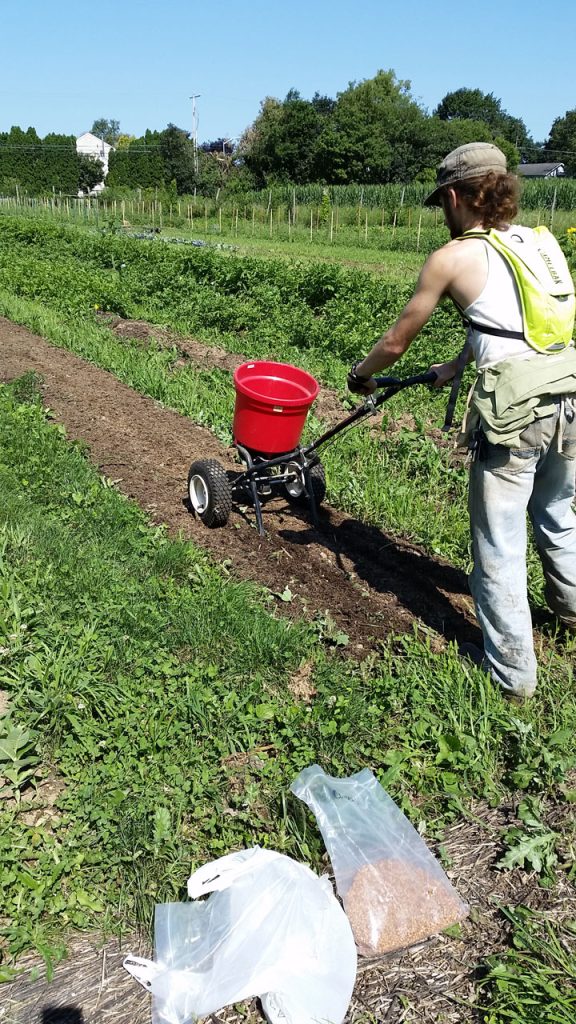How the Use of Cover Crops Can Promote Soil Health for Beginners

Understanding the Numerous Advantages of Cover Crops in Agriculture
The agricultural landscape is evolving, and with it comes an increased awareness of sustainable practices. One such practice gaining traction is the use of cover crops, which play a crucial role in enhancing soil health. These crops, which are planted primarily to cover the soil rather than for the purpose of harvesting, offer a multitude of benefits that bolster not only the immediate productivity of farmland but also contribute to long-term ecological stability.
Beginning farmers and seasoned growers alike often overlook the importance of soil vitality. However, understanding the benefits of cover crops can lead to better yield and healthier ecosystems. Here are some key advantages:
- Preventing soil erosion: Cover crops serve as a protective blanket over the soil, effectively holding it in place. This action significantly reduces the impact of wind and water erosion, which can lead to substantial topsoil loss. For instance, in regions like the Midwest, where heavy rainfall can wash away nutrient-rich soil, cover crops have become a proven strategy to protect against such erosion.
- Improving soil structure: The diverse root systems of cover crops, such as radishes or clover, help to create channels in the soil. This natural aeration promotes better water infiltration and improves soil structure, allowing for a healthier environment for future crops. Improved soil structure increases the soil’s capacity to retain moisture, thereby reducing reliance on irrigation in periods of drought.
- Enhancing nutrient content: Certain cover crops, particularly legumes like vetch or crimson clover, have the unique ability to fix nitrogen from the atmosphere into the soil. This process enriches the soil, making it more fertile for subsequent crops. For farmers, this translates into reduced fertilizer costs and healthier plants, which can lead to higher yields.
In addition to these benefits, cover crops act as a crucial line of defense against pests and diseases. By offering a habitat for beneficial organisms, they foster biodiversity within the ecosystem. This not only aids in pest management but also supports pollinators, which are vital for crop production.
As we dive deeper into the world of cover crops, it becomes evident how valuable they are for promoting soil health. This exploration serves both novice gardeners and experienced farmers looking to rejuvenate their land. In the face of climate change and fluctuating weather conditions, the resilience offered by cover crops is an essential consideration for those looking to cultivate sustainably and effectively.
Ultimately, adopting cover crops is not merely a trend but an investment in the future of agriculture. By enhancing soil health, farmers are ensuring that their practices are not only productive but also responsible, paving the way for generations to come. This dual focus on productivity and sustainability will lead to more resilient farming systems across the United States, encouraging a thriving ecological balance in the process.

LEARN MORE: Click here to discover essential tools
The Role of Cover Crops in Boosting Soil Microbial Activity
One of the most profound impacts of cover crops on soil health lies in their ability to enhance microbial activity. Microorganisms, including bacteria and fungi, are essential for breaking down organic matter and releasing nutrients that plants need to thrive. Cover crops create more organic material through their leaves and roots, which can significantly increase the number and diversity of these microbes, contributing to a more robust soil ecosystem. Understanding how this process works can equip beginning farmers with the knowledge to harness the full power of their soil.
When cover crops are planted, they grow and eventually die, adding organic matter to the soil. This decomposition process not only enhances the soil structure but also boosts microbial activity as these organisms feast on the decomposing organic materials. A vibrant microbial community can improve nutrient cycling, leading to better plant health. Here are some specific ways that cover crops promote beneficial microbial activity:
- Creating organic matter: The roots of cover crops create pathways for microorganisms, and when the plants die back, their biomass directly contributes to the organic matter in the soil. This added organic matter is crucial in improving soil fertility while also serving as a food source for earthworms and beneficial microbes.
- Encouraging nitrogen-fixing bacteria: Leguminous cover crops, such as hairy vetch and sweet clover, have a symbiotic relationship with nitrogen-fixing bacteria. This means they convert atmospheric nitrogen into a form that is readily available for other plants. Enhanced nitrogen availability leads to healthier crops and reduced need for chemical fertilizers.
- Promoting mycorrhizal fungi: Cover crops help to foster relationships with mycorrhizal fungi, which enhance nutrient uptake for plants. These fungi extend their root networks into the soil, allowing plants greater access to essential phosphorus and other nutrients that are often bound tightly in the soil. This relationship offers plants greater resilience against disease and environmental stress.
The advantages of improved microbial activity go beyond just individual crop health. A thriving microbial community contributes to the overall resilience of the soil, making it more capable of withstanding droughts and excessive rainfall. For beginning farmers, building a strong soil ecosystem through cover crops can lead to less reliance on chemical inputs, which can be both costly and harmful to the environment.
As we explore cover crops further, it becomes apparent that their positive influence extends into various facets of soil health. By nurturing the microbial populations within the soil, farmers not only enhance productivity but also reinforce sustainable agricultural practices. This approach fosters an agricultural environment where soils can maintain their integrity and productivity for generations to come, an essential consideration in today’s rapidly changing climate.
| Advantages | Impact on Soil Health |
|---|---|
| Enhanced Soil Structure | Planting cover crops improves soil aeration and promotes a healthy ecosystem for beneficial microorganisms. |
| Reduction of Erosion | Cover crops create a protective layer, minimizing soil erosion from wind and water, which is crucial for maintaining soil health. |
| Nutrient Retention | These plants play a key role in absorbing and recycling nutrients, reducing the need for chemical fertilizers. |
| Weed Suppression | By providing ground cover, these crops actively compete with weeds, leading to less weed pressure and healthier crops. |
Understanding these advantages is critical for beginners looking to integrate cover crops into their farming practices. Not only do cover crops foster a robust soil ecosystem, but they also empower farmers to cultivate more sustainable and productive harvests. This approach invites farmers to explore additional agronomic strategies that can further enhance their soil’s vitality and resilience. The benefits go beyond immediate soil improvement; they contribute to long-term agricultural sustainability and climate resilience. As interest in organic practices grows, understanding how cover crops function can position new farmers at the forefront of the movement towards soil health enhancement.
DISCOVER MORE: Click here to learn about indoor plants that purify the air
The Impact of Cover Crops on Soil Structure and Erosion Control
Beyond their role in enhancing microbial activity, cover crops play a crucial part in improving soil structure and offering protection against erosion. For beginners in agriculture, understanding how cover crops can defend against soil degradation and compaction is essential for maintaining soil health over the long term. Strong soil structure leads to better infiltration of water and air, which are vital for vigorous plant growth.
Cover crops possess deep root systems that work diligently to break up compacted soil layers. This root penetration allows for better aeration and water retention, creating a more congenial environment for both plant roots and beneficial soil organisms. As the roots die and decompose, they leave behind channels and voids in the soil which further improves its porosity. Here are some notable benefits that cover crops offer regarding soil structure and erosion control:
- Reduction of soil erosion: During rainstorms, bare soil is subject to erosion by water and wind. Cover crops provide a protective canopy that shields the soil surface, significantly reducing the impact of heavy rains. Studies have shown that fields with cover crops experience substantially lower erosion rates than those left bare. This protective layer not only limits the loss of valuable topsoil but also aids in nutrient retention.
- Enhanced soil aggregation: The organic matter contributed by cover crops fosters the formation of soil aggregates, which are clusters of soil particles that bind together. These aggregates create spaces that allow for improved water infiltration while also minimizing erosion risk. Healthy aggregates lead to better root growth and nutrient availability, which are paramount for crop success.
- Water retention: By decreasing the amount of runoff and improving soil structure, cover crops help maintain moisture levels in the soil. This characteristic is especially beneficial during dry spells, as it enables crops to remain viable longer without supplemental watering. For beginning farmers in areas affected by drought, using cover crops can be a strategic way to conserve water and support crops through challenging weather conditions.
Research conducted at various agricultural universities in the United States emphasizes the long-term advantages of integrating cover crops into farming practices. For example, trials have demonstrated that utilizing cover crops, specifically in the Midwest, can reduce soil erosion by up to 80%. This is a substantial finding for new farmers looking to establish sustainable practices while also increasing their crop yields.
Furthermore, cover crops provide an economical solution for managing weeds. When cover crops outgrow weeds, they help suppress the invasive species naturally without resorting to chemical herbicides. This not only cuts down costs for farmers but also contributes to a healthier ecosystem. It’s a win-win scenario that appeals to both conventional and organic growers.
Ultimately, implementing cover crops isn’t just about improving soil health; it concerns cultivating a holistic approach to farming practices that support environmental sustainability. By embracing the multifaceted advantages that cover crops offer, beginning farmers can set the foundation for a long-lasting, productive agricultural enterprise capable of thriving in the face of modern challenges.
DISCOVER MORE: Click here for essential tools
Conclusion: Embracing Cover Crops for Sustainable Soil Health
In summary, cover crops represent a powerful tool for beginners looking to enhance soil health and promote sustainable farming practices. The multifaceted benefits they offer—ranging from improved soil structure and erosion control to enhancing water retention—profoundly impact agricultural productivity and ecological balance. By incorporating cover crops into their land management strategies, novice farmers not only safeguard against soil degradation but also establish a foundation for healthier, more resilient ecosystems.
Furthermore, the financial benefits of using cover crops cannot be overlooked. The reduction in erosion and the increased resilience to drought conditions lead to better crop yields, while their natural ability to suppress weeds diminishes the need for costly herbicides. This creates an environmentally friendly approach that aligns well with the growing emphasis on sustainability in agriculture.
For those just starting out in agriculture, investing time to understand the varieties of cover crops and their unique benefits is crucial. Many resources, including local agricultural extensions and online guides, provide invaluable insights tailored to specific regional climates and soil types. As the conversation around sustainable practices continues to evolve, the adoption of cover crops stands out as an innovative and effective strategy that can be embraced by anyone eager to improve soil health and ensure productive farming for years to come.
Ultimately, integrating cover crops into your farming practice is not merely an option; it is an essential step in paving the way for a flourishing agricultural future, conducive to both crop success and environmental stewardship.



